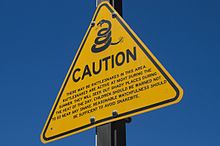You might recently have heard on the news that a 14-year-old boy was airlifted out of Mission Trails Regional Park in San Diego, California after a rattlesnake bit his leg. In Arizona, an adult was badly bitten on the knuckle of his middle finger. At the hospital, the man who nearly lost his finger from the bite said, "It felt like having your finger injected with molten lava. The pain was intense and immediate, the swelling was dramatic, almost instantaneous." He had to be treated with 23 vials of costly anti-venom.
Isn't it too early in the season to have to worry about snake bite? Shouldn't these venomous creatures still be hibernating until March or April? Well, that depends. A warmer than expected winter in some places has caused snakes to come out of hibernation earlier than usual. In fact, in warmer southern states, snakes often don't go into hibernation at all. Instead, they go into "brumation."
Hibernation is a deep sleep, usually occuring in colder, snow covered climates in northern states. Snakes don't actually sleep in brumation, but their bodies acclimate to a lower temperature, their metabolism slows, and they become less active and less inclined to feed. Brumation or hibernation is necessary for breeding. If male snakes don't cool down at some point during the year, they most likely would not be able to produce fertile sperm.
On warm days, brumating snakes sometimes come out of their dens to bask in the sunshine. Nice sunny winter days are often when people are surprised by snakes. Just like humans, snakes head out to enjoy the sun and unsuspecting hikers can startle them and cause them to strike. As a rule of thumb, rattlesnakes can strike a distance of two-thirds their total body length. That means a three foot long snake may be able to strike a distance of two feet. The best advice is to stay alert when recreating in environments where snakes are known to live. If you see a snake or hear it rattle, take one big step back so you're immediately out of striking range. Rattlesnakes usually try to get way from people and bite only when attacked -- or when they perceive they are being threatened or attacked. Many bites occur when snakes are accidentally stepped on. Wear snake gaiters or snake proof boots and you'll know you're protected in case that happens.
Generally, rattlesnakes emerge from hibernation in March or April, or when the average daytime temperatures reach and remain about 60 degrees Fahrenheit and higher. In the spring, keep in mind that emerging snakes are hungry, thirsty, and ready for love! They are most active in 80-degree temperatures. With spring approaching, follow the Boy Scout motto and be prepared. Whether you are of the mindset that rattlers and other dangerous snakes have their place in the ecosystem and should be left alone when encountered, or think the only good rattler is a dead rattler, don't take a chance. Wear snake gaiters or snake boots and you'll know you're protected when in the desert or woods.